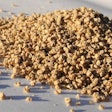Former USDA Ag Secretary Richard Lyng during his term over 25 years ago used to say soybeans are one of our most efficient commodities we grow. Lyng was making the point that the supply and demand balance for soybeans would adjust fairly quickly to each other. When the supply of soybeans would increase, demand would follow and vice versa.
In just a few days, USDA will confirm a record supply of soybeans for the 2014/15 crop, relative to a record planted acres and, most likely, a record yield per acre. For users of soybean products, the last seven years have been challenging, as the ending carryover for soybeans has caused a minimal supply of just 2 to 3.5 weeks going back to 2007. The 2014/15 soybean crop should increase the carryover estimate to better than a six week supply of soybeans. Improved soybean supplies are a giant leap in terms of a one-year adjustment after perhaps a slower adjustment than Lyng’s comment. However, corn demand for ethanol over those same seven years obviously influenced more corn acres vs. soybean acres so the balance between supply and demand for soybeans was slightly displaced, but is catching up … in one giant leap.
Large soybean supply represents shift for feed commodities
The large soybean supply is a major shift for feed commodities. To illustrate, the “U.S. Soybean Supply & Demand” chart shows a vertical percent change of each category of a supply and demand balance sheet. The take-away from this illustration is a small increase in planted acres of nearly 11 percent and roughly a 6 percent improvement in yield over 2013 causes a very large increase in soybean ending/carryover stocks.
Demand for soybeans should improve from our current estimates over the next twelve months in the crush and export category. Regarding exports, the quality of the soybean crop should be favorable given the good weather. Export bookings of soybeans to date for the new crop year starting September 1 have also been solid. However, there is going to be some logistical transportation challenges in getting soybeans out of the U.S. Moving soybeans to the export locations of the Louisiana Gulf or the Pacific Northwest will likely challenge merchandisers and shippers. We believe the robust crop in Missouri, which is the fourth largest soybean producing state, should be able to be move soybeans to the Louisiana Gulf easier than North Dakota, which is the fifth largest soybean producing state, and will move soybeans to the Pacific Northwest export market. Illinois, Iowa and Minnesota are the first, second and third largest soybean producing states, respectively.
These five states have 39.4 million acres planted or 46.4 percent of all planted acres. With crop ratings being as high as they are in good to excellent condition as of August 3, these states should have close to 50 percent of the U.S. supply. While a large crop is welcomed by soybean users, and the market is in the process of bringing prices down, bargain prices will become a relative matter based on the transportation cost of getting the physical product to the ultimate user.
Outlook for soybean prices
To bring together all of the above into a price perspective, our current belief is soybeans have not made a low in price and have more downside price potential as well as for soybean oil and soymeal. The weather outlook is mostly good to near perfect to allow for the crop to finish well and be a bountiful harvest.
One further element of support to our current view is from a weekly U.S. Commodity Futures Trading Commission (CFTC) report, called the Commitment of Traders report. Each week, the CFTC gathers data from all firms that process futures and options trading by all participants. The soybean trade chart shows who is long or short futures. More specifically, a long (buy) position is above zero and a short (sell) is below zero. For soybeans, the latest data available show the Commercial Trader, who typically is the buyer (elevators and crushers) of soybeans from farm producers, is long soybean futures. Given a record crop about to be harvested, the Commercial Trader should be short futures as a hedge or soybeans purchased from farmers. It is a normal business practice for the Commercial Trader to hedge (short) futures and maintain that position until those bushels are either consumed or traded to someone else. For those not familiar with this reporting system, it may mean nothing to you. However, this report is the commodity industry’s best attempt at transparency while maintaining anonymity for all participants who use futures and options to manage their market risks.
It is our belief that there should be some portion of the record crop in the field being priced by producers and hedged by Commercial Traders since the crop is in the field and not being consumed … yet.
Tim Brusnahan joined Brock Associates in 1985 and provides commodity price forecasting, research analysis, hedging and marketing strategies for crop producers, dairy and livestock producers and procurement/risk management strategies for feed manufactures, corn processors, and other end users. Contact Brusnahan at 414.540.2607 and [email protected] .
The views and opinions expressed are not a solicitation of trading futures and options contracts. There is risk of losses as well as profits when trading futures and options, careful consideration to all risk aspects of commodity/derivative trading should be considered before trading, and past performance is no indication of future results.
.jpg?auto=format%2Ccompress&crop=faces&fit=crop&h=48&q=70&w=48)






